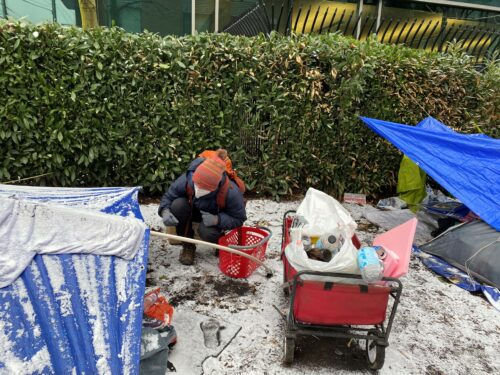Meeting people who are houseless is not new for Julia Paulsen and Caitlin Gleeson.
As staff for Catholic Charities of Oregon, their weekly work includes outreach and encounters with houseless people in the busy area around St. Francis Parish in inner Southeast Portland. The pair bring water, snacks, socks and other gear prized by people living on the streets.
But at the start of the year, the pair ranged more widely, finding even more camps and asking more questions
It was the Point in Time Count, when cities and counties nationwide get a sense of how many people are experiencing houselessness. Paulsen and Gleeson walked beneath bridges and freeway underpasses, through vacant lots and into urban nooks and crannies.

PIT SETTING OFF
Caitlin Gleeson and Julia Paulsen of Catholic Charities’ homeless outreach services set off on the annual Point in Time Count in January. The backpacks are full of items to be offered to people who are houseless.
“It’s shocking to see where people are,” said Paulsen, coordinator of outreach services. “It’s a lot of walking, a lot of navigating neighborhoods. We’re trying to be as accurate as possible.”
While some houseless people agreed to help, others felt wary, said Gleeson, a Jesuit Volunteer who serves as an outreach specialist.
To receive federal housing dollars, communities must conduct the Point in Time Count at least every other year. Advocates for those experiencing houselessness, including Paulsen, say the survey is an imperfect system that severely undercounts women, people of color, homeless youth, and others who are less likely to engage in traditional services. But still, the tally is vital to allocate federal support properly.
“The Housing Transition Program and their reputation as advocates for self-identified women, including trans women, is uniquely positioned to ensure that the women we serve are counted, which then creates additional resource priorities for those populations,” says Rose Bak, chief program officer for Catholic Charities of Oregon who formerly worked at Multnomah County and helped shape the local count effort. “The Portland community as a whole has worked hard to make our count much more inclusive compared to others. Most communities just do a cursory survey, but our community engages in a larger effort because we believe everyone on the street has value and deserves to be included and recognized.”
Portland is divided into zones for the count and various agencies step up to cover those places. Catholic Charities counts and takes surveys along the southeast waterfront, inner Southeast Portland and in the Hollywood district of Northeast Portland.
As Paulsen and Gleeson counted in January and February, they met many regulars who were glad to see them. The feeling was mutual.
Questions on the three-minute state-created survey included queries about where people slept on the night of the count — Jan. 24 — how long people have been houseless, whether they had been in the same situation before, whether they used drugs or alcohol and what their gender identity is.
The Point in Time Count this year included a stretch of below-freezing temperatures.
Gleeson said about 95% of the houseless people they met during the count identify as male. The women usually were paired with a man.
“It’s really about who feels comfortable staying outside,” said Paulsen, who also took part in the 2022 count when she was serving at Catholic Charities as a Jesuit Volunteer.
Paulsen and Gleeson say they often observe how houseless people will form small communal groups. Members keep watch over each other’s belongings and share stories and laughs. Many groups have dogs. During the count, one little street family’s dog had just had puppies. Paulsen and Gleeson’s forms did not have a space for counting canines.

SNOWY TENT
Julia Paulsen surveys a person in a snow-covered tent during the Point in Time Count in 2022.
They found no children on their count. But officials say that many children are homeless and may be couch surfing as they attend school.
Paulsen and Gleeson report that they never felt endangered during the survey. They are trained on moving along if someone might be agitated.
“The Point in Time Count is a critical census of people experiencing houselessness in our area,” says Victoria Waldrep, program supervisor for Catholic Charities’ Housing Transitions Program. “This count allows us to track trends in certain communities that are served by our system to allow us to provide targeted services to those in need.”
The Housing Transitions Program was created in 2006 because of the unmet need of women without children in their care who are experiencing houselessness. The count has confirmed that this houseless population has continued to grow, as has the number of houseless BIPOC people and those who identify as LGBTQIA+.
